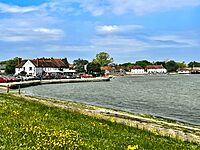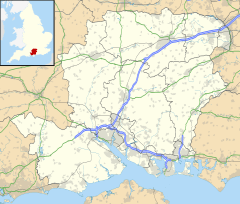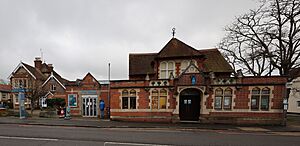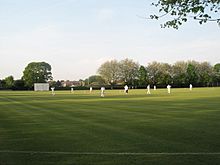Havant facts for kids
Quick facts for kids Havant |
|
|---|---|
 Langstone Harbour  St Faith’s Church |
|
| Area | 20.34 km2 (7.85 sq mi) |
| Population | 45,826 (2011 census) |
| • Density | 2,253/km2 (5,840/sq mi) |
| OS grid reference | SU717062 |
| District |
|
| Shire county | |
| Region | |
| Country | England |
| Sovereign state | United Kingdom |
| Post town | HAVANT |
| Postcode district | PO9 |
| Dialling code | 023 |
| Police | Hampshire |
| Fire | Hampshire |
| Ambulance | South Central |
| EU Parliament | South East England |
| UK Parliament |
|
Havant is a town in the south-east part of Hampshire, England. It is located between the cities of Portsmouth and Chichester. The wider area around Havant, called its borough, includes the town itself (with about 45,826 people), the holiday spot of Hayling Island, and the towns of Waterlooville and Emsworth.
After World War II, the number of homes and people in Havant more than doubled. This happened as farms and woodlands were turned into new housing areas. Many people moved here after Portsmouth was heavily bombed during the war.
The very old part of Havant was a small settlement even before Roman times. After World War II, more people moved to Havant, including those who had retired or who traveled to work in nearby cities. Because of this, Havant is now often seen as part of the larger Portsmouth city area.
Contents
History of Havant
Scientists digging in the ground in the 1800s and 1900s found signs of Roman buildings in Havant. They also found tools and remains from even older times, like the Stone Age.
Around the year 935, Havant was known as 'Hamafunta', which meant 'the spring of Hama'. This name came from a natural spring located south-west of St Faith's Churchyard. A settlement grew here because it was a good place where paths from the hills met paths running along the coast.
In 1086, when the Domesday Book was written, Havant was a small village with about 100 people. In 1200, monks from Winchester Cathedral were given permission to hold a market in Havant. Later, around 1450, an annual fair was also held in the town.
For a long time, water was very important for businesses in Havant. There were many water mills used for making things like parchment (a material for writing) and brewing drinks.
A big fire in 1760 destroyed most of Havant. Only the church and some old cottages from the late 1500s or early 1600s survived. These cottages are now a pub called "The Old House at Home". People say that some wooden beams inside the pub came from ships of the Spanish Armada.
The fire helped the town in some ways, as it allowed the roads to be made wider. This made it easier for stagecoaches to travel through Havant. The Bear Hotel and Dolphin Hotel were famous places where coaches would stop. Havant also experienced small earthquakes in 1784 and 1811.
Hall Place, a large house on South Street, was rebuilt in 1796. It is a Grade II-listed house, meaning it is historically important. It was built in the Georgian style, using buff-colored bricks.
The oldest parts of St Faith's Church, like the main part where the altar is, were built in the early 1200s. Some people believe that parts of its foundations might even be from Roman times.
Havant got its first postmaster in 1768. The current post office building in East Street opened in 1936.
In 1847, Havant got its first railway station, connecting it to Portsmouth and Brighton. A direct train line to London opened in 1859. There was also a branch line to Hayling Island from 1867 until the mid-1960s.
The first hospital in Havant opened in 1894. A war memorial hospital opened in 1929. In 1935, a special decoration of Wedgwood tiles showing nursery rhymes was added to the children's ward.
The number of people living in Havant grew a lot from 1939 to 1961. Since then, the growth has slowed down, but the population still nearly doubled in 50 years up to 2011.
Geography of Havant
The old town centre of Havant is built around a classic crossroad design. The four main streets are North Street, East Street, South Street, and West Street, with St Faith's Church at the very centre. One of these roads is known to be an old Roman road.
The main A27 road separates the town from coastal villages like Langstone and parts of Bedhampton. To the north of Havant is Leigh Park, a large area of council housing built before 1960. Beyond Leigh Park is Staunton Country Park, which is part of the beautiful South Downs National Park. To the east, Havant connects with the town of Emsworth. To the west are Portsdown Hill and more of Bedhampton. The A3(M) motorway also passes to the west.
There are several natural springs in the area. One is a short distance south-west of the church on West Street. This spring was once used by a major parchment-making factory, which closed in 1936. This factory later became a glove-making and leather processing plant. It is said that the famous Treaty of Versailles, which ended World War I, was written on parchment made in Havant.
Economy and Shopping
After World War II, Havant's businesses grew, and more people who had retired or traveled to work moved there. This made Havant an important part of the Portsmouth city area. In 2011, this combined area was one of the 20 largest in the UK.
The main shopping area in Havant is called Meridian Shopping. There is also a pedestrian-only part of West Street where you can shop. The old town hall building is now The Spring Arts & Heritage Centre, a place for arts and history. Havant is also home to Angel Radio, a local radio station that plays music from before the 1960s.
Transport in Havant
Havant has a bus station next to the Meridian Shopping Centre, which is a short walk from the railway station. The main bus company is Stagecoach South. They offer services to places like Portsmouth, Hayling Island, Leigh Park, Waterlooville, Petersfield, Emsworth, and Chichester.
The railway station is on North Street, with the current buildings dating from 1938. You can catch direct and frequent trains from Havant to London Waterloo and Portsmouth Harbour.
Education in Havant
Before 1870, there were private schools in Havant. But after the 1870 Education Act, Havant got its first state schools. These included schools in Brockhampton Lane, West Street, and Fairfield Road. A newer school, Bosmere Junior School, opened in 1985.
In 2017, Havant College and South Downs College joined together to form Havant and South Downs College.
Sports in Havant
Havant has several successful sports teams. The town's main football team is Havant & Waterlooville F.C.. In 2008, they made history by reaching the fourth round of the FA Cup, a big football competition. They even led twice against Liverpool in that match before losing 5-2.
For rugby, there is Havant RFC, which started in 1951. Havant HC (Havant Hockey Club), founded in 1905, has won the Men's England Hockey League three times. Several players from Havant Hockey Club were part of the British team that won an Olympic gold medal in 1988. Two players also went to the 2006 Commonwealth Games.
Havant also has a successful amateur cricket club, founded in 1876. Havant Cricket Club has won the Southern Premier Cricket League several times.
The town is also home to a rifle and pistol club. An Olympic gold medalist, Malcolm Cooper, trained there before winning medals in 1984 and 1988.
The Avenue (Tennis) Club in Havant has ten high-quality grass tennis courts.
Places of Worship
Havant's main Church of England church is St. Faith's. Parts of this church are very old, dating back to the 1100s. The Roman Catholic church, St. Joseph's, was built in 1875. There is also a United Reformed Church on North Street, built in 1891.
Images for kids
See also
 In Spanish: Havant para niños
In Spanish: Havant para niños










